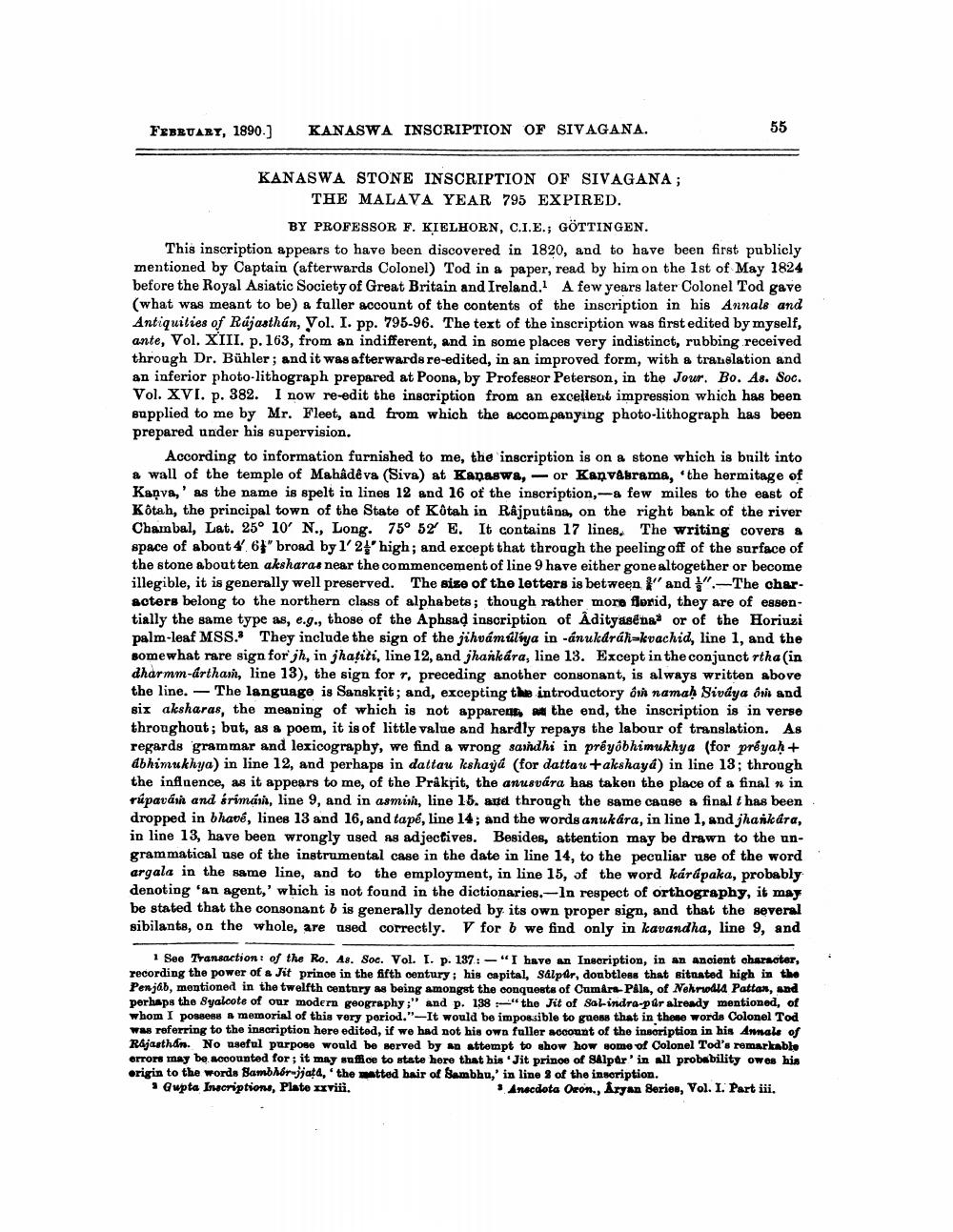________________
FEBRUARY, 1890.)
KANASWA INSCRIPTION OF SIVAGANA.
55
KANASWA STONE INSCRIPTION OF SIVAGANA;
THE MALAVA YEAR 795 EXPIRED.
BY PROFESSOR F. KIELHORN, C.I.E.; GÖTTINGEN. This inscription appears to have been discovered in 1820, and to have been first publicly mentioned by Captain (afterwards Colonel) Tod in a paper, read by him on the 1st of May 1824 before the Royal Asiatic Society of Great Britain and Ireland. A few years later Colonel Tod gave (what was meant to be) a fuller account of the contents of the inscription in his Annals and Antiquities of Rajasthan, Vol. I. pp. 795-96. The text of the inscription was first edited by myself, ante, Vol. XIII. p. 163, from an indifferent, and in some places very indistinct, rubbing received through Dr. Bühler; and it was afterwards re-edited, in an improved form, with a translation and an inferior photo-lithograph prepared at Poona, by Professor Peterson, in the Jour. Bo. As. Soc. Vol. XVI. p. 382. I now re-edit the inscription from an excellent impression which has been supplied to me by Mr. Fleet, and from which the accompanying photo-lithograph has been prepared under his supervision.
According to information furnished to me, the inscription is on & stone which is bnilt into a wall of the temple of Mahadeva (Siva) at Kanaswa, - or Kanvabrama, the hermitage of Kanva,' as the name is spelt in lines 12 and 16 of the inscription,-a few miles to the east of Kotah, the principal town of the State of Kotah in Rajputâna, on the right bank of the river Chambal, Lat. 25° 10' N., Long. 750 52 E. It contains 17 lines. The writing covers & space of about 4.6}" broad by 1'2' high; and except that through the peeling off of the surface of the stone about ten aksharas near the commencement of line 9 have either gone altogether or become illegible, it is generally well preserved. The size of the letters is between '' and ".-The characters belong to the northern class of alphabets; though rather more florid, they are of essentially the same type as, e.g., those of the Aphsad inscription of Adityasena or of the Horiuzi palm-leaf MSS. They include the sign of the jihvámúliya in -ánukdráh=kvachid, line 1, and the somewhat rare sign for jh, in jhatiti, line 12, and jhankára, line 13. Except in the conjunct rtha (in dharmm-arthan, line 13), the sign for t, preceding another consonant, is always written above the line. — The language is Sanskrit; and, excepting the introductory ô namah Sivaya ori and six aksharas, the meaning of which is not apparent the end, the inscription is in verse throughout; but, as a poem, it is of little value and hardly repays the labour of translation. As regards grammar and lexicography, we find a wrong saindhi in préyobhimukhya (for préyah + dbhimukhya) in line 12, and perhaps in dattau kshayá (for dattau+akshayd) in line 13; through the influence, as it appears to me, of the Pråksit, the anusvára has taken the place of a final in rúpavári and Srimárn, line 9, and in asmih, line 15. and through the same cause a final t has been dropped in bhavé, lines 13 and 16, and tapé, line 14; and the words anukara, in line 1, and jhankdra, in line 13, have been wrongly used as adjectives. Besides, attention may be drawn to the ungrammatical use of the instrumental case in the date in line 14, to the peculiar use of the word argala in the same line, and to the employment, in line 15, of the word kárápaka, probably denoting 'an agent,' which is not found in the dictionaries.-In respect of orthography, it may be stated that the consonant b is generally denoted by its own proper sign, and that the several sibilants, on the whole, are used correctly. V for b we find only in kavandha, line 9, and
See Transaction of the Ro. As. Soc. Vol. I. p. 137:-"I have an Inscription, in an ancient character, recording the power of & Jit prince in the fifth century: his capital, salpar, doubtless that sitnated high in the Penjab, mentioned in the twelfth century as being amongst the conquesta of Oumare Pala, of Nehrdla Pattan, and perhaps the Byalcote of our modern geography;" and p. 138 - "the Jit of Salindra-per already mentioned, of whom I possess a memorial of this very poriod."-It would be impossible to guess that in these words Colonel Tod was referring to the inscription here edited, if we had not his own fuller account of the inscription in his Annals of Rajasthan. No useful purpose would be served by an attempt to show how some of Colonel Tod's remarkable errors may be accounted for; it may suffice to state here that his 'Jit prince of Alper' in all probability owes his origin to the words Sambor-jjata, 'the matted hair of Sambhu,' in line 3 of the inscription. . Gupta Inscriptions, Plato xxviii.
Anecdota Oxon., Aryan Series, Vol. I. Part iii.




